| Home Page | Embryology | Anatomy | Innervation | Physiology | Clinic Case |
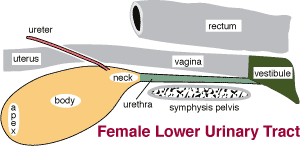 |
 |
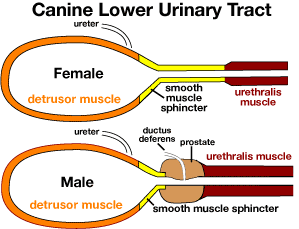 • Anatomically, the lower urinary tract = urinary bladder and urethra plus the caudal ureter. The male urethra consists of pelvic and penile components.
• Anatomically, the lower urinary tract = urinary bladder and urethra plus the caudal ureter. The male urethra consists of pelvic and penile components.
• Functional components of the lower urinary tract are determined by innervation:
detrusor muscle, which expels urine, is the smooth muscle coat of the bladder apex and body;
smooth muscle sphincter (internal urethral sphincter) is the muscle coat of the bladder neck & cranial urethra;
striated urethral sphincter (external urethral sphincter) is the urethralis muscle which encircles the caudal urethra.
• There are three urinary bladder regions:
apex = cranial blind end;
neck = funnel-shaped region between ureter openings and urethra; and
body = region situated between the neck and apex.
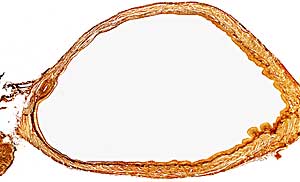 |
 |
•Each ureter empties into the urinary bladder by a slit opening at the cranial margin of the vesical neck. The terminal ureter passes obliquely through the bladder wall. As intravesical pressure rises, tension in the bladder wall acts to close the intramural ureter and preclude urine reflux. (Ureter smooth muscle must generate enough peristaltic force for a urine bolus to open the terminal ureter.)
• The bladder trigone is evident as triangular area of smooth mucosa inside the dorsal wall of the bladder neck. The trigone attaches the ureters to the bladder neck and urethra. The cranial border of the trigone is formed by longitudinal muscle fascicles from each ureter crossing the midline. The lateral borders and apex are formed by ureter longitudinal muscle fascicles that continues caudally into the urethral crest.
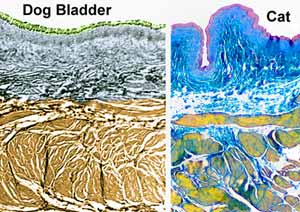 • The urinary bladder and the ureter are lined by transitional epithelium. The urothelium is bacteriostatic by virtue of a glycosaminoglycan secretion that impairs bacterial adhesion to the epithelium. During cystitis, molecules released by urothelium affect afferent nerve endings, producing bladder pain and hyperactivity.
• The urinary bladder and the ureter are lined by transitional epithelium. The urothelium is bacteriostatic by virtue of a glycosaminoglycan secretion that impairs bacterial adhesion to the epithelium. During cystitis, molecules released by urothelium affect afferent nerve endings, producing bladder pain and hyperactivity.
• The smooth muscle coat of the apex and body of the bladder constitutes the detrusor muscle. Its muscle fascicles are variably organized rather than arranged in consistent layers. As the bladder distends, the muscle coat becomes thinner and individual muscle fascicles shift their positions relative to one another. (Note: The term "detrusor" comes from the Latin word meaning "thrust down" which is how it works to expel urine in people.)
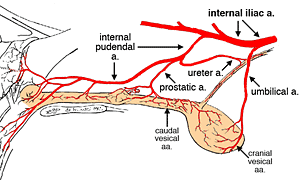 • In contrast to the detrusor, the bladder neck has a sphincter function. The submucosa of the bladder neck is relatively rich in elastic fibers. Muscle fascicles of the neck are predominantly circular (they continue into the urethra). Oblique muscle fascicles of the detrusor run onto the bladder neck in order to pull it open.
• In contrast to the detrusor, the bladder neck has a sphincter function. The submucosa of the bladder neck is relatively rich in elastic fibers. Muscle fascicles of the neck are predominantly circular (they continue into the urethra). Oblique muscle fascicles of the detrusor run onto the bladder neck in order to pull it open.
• Blood supply: The internal iliac artery supplies the lower urinary tract. The umbilical artery supplies cranial vesical arteries to the apex of the bladder. The internal pudendal artery, which terminates in the vestibule/penis, gives off a vaginal/prostatic artery that supplies the bladder (caudal vesical arteries) and urethra.
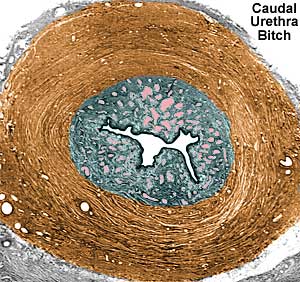 • Female urethrae are anatomically similar in dogs and cats. The female urethra runs from the internal urethral orifice at the bladder neck to the external urethral orifice which opens on the floor of the cranial vestibule in a urethral tubercle (dog) or as a groove (cat).
• Female urethrae are anatomically similar in dogs and cats. The female urethra runs from the internal urethral orifice at the bladder neck to the external urethral orifice which opens on the floor of the cranial vestibule in a urethral tubercle (dog) or as a groove (cat).
• Transitional epithelium lines the urethral lumen (2-3 cells thick). Urethral epithelium gradually becomes stratified cuboidal in the mid urethra and stratified squamous at the termination. Urethral submucosa contains more elastic fibers than the bladder and a stratum spongiosum (venous sinuses) that is more plentiful caudally. The urethral crest is a dorsal submucosal ridge that contains longitudinal muscle fascicles from the ureter.
 • The urethral muscle coat is circular smooth muscle in the cranial two-thirds of the urethra and striated muscle in the caudal third. The muscle types overlap in the canine mid-urethra and further caudally in the cat. Along with the bladder neck, urethral smooth muscle constitutes the internal urethral sphincter.
• The urethral muscle coat is circular smooth muscle in the cranial two-thirds of the urethra and striated muscle in the caudal third. The muscle types overlap in the canine mid-urethra and further caudally in the cat. Along with the bladder neck, urethral smooth muscle constitutes the internal urethral sphincter.
• Striated urethralis muscle (external urethral sphincter) entirely replaces smooth muscle in the distal third of the urethra. The striated muscle encircles the urethra and further caudally it encircles both urethra and vagina together.
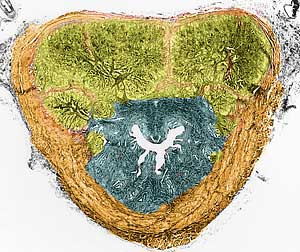 • A small prostate gland is positioned in the middle of the pelvic urethra of the male cat. The body of the prostate is a landmark for dividing the pelvic urethra into preprostatic, prostatic, and postprostatic divisions.
• A small prostate gland is positioned in the middle of the pelvic urethra of the male cat. The body of the prostate is a landmark for dividing the pelvic urethra into preprostatic, prostatic, and postprostatic divisions.
• The preprostatic urethra extends from the bladder neck to the prostate gland and resembles the cranial half of the female urethra. The smooth muscle coat is circular, like the bladder neck. Longitudinal fascicles from the trigone are evident dorsally in a urethral crest.
• The prostatic urethra is ventral to the body of the prostate gland. The submucosa is rich in elastic fibers but generally deficient in smooth muscle. A bilateral opening of each ductus deferens and numerous prostatic ducts are visible on the colliculus seminalis, a dorsal region of thickened submucosa.
• The feline prostate gland is bi-lobed and positioned dorsally on the urethra. Each lobe is composed of lobules partitioned by trabeculae. Smooth muscle is present within trabeculae and as a thin coat on the surface of the prostate, but smooth muscle does not surround the submucosa and lumen of the prostatic urethra. Postprostatic striated muscle fascicles coat the ventral surface of the prostatic urethra.
• The postprostatic urethra runs from the body of the prostate gland to the root of the penis where paired bulbourethral glands are present in the cat. The postprostatic submucosa features a rich stratum spongiosum and disseminated glandular tissue. The striated urethralis muscle forms a thick muscle coat encircling urethral submucosa and entirely replacing smooth muscle. (Striated fascicles cover each bulbourethral gland as bulboglandularis muscle).
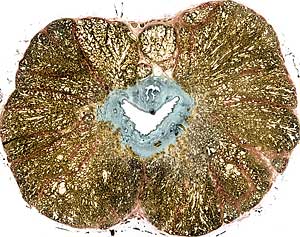 • The pelvic urethra of the male dog has two divisions: prostatic and postprostatic. A large bi-lobed prostate gland completely encircles the prostatic urethra. Within the prostate, the urethral lumen appears enlarged and a prominent colliculus seminalis occupies the dorsal submucosa.
• The pelvic urethra of the male dog has two divisions: prostatic and postprostatic. A large bi-lobed prostate gland completely encircles the prostatic urethra. Within the prostate, the urethral lumen appears enlarged and a prominent colliculus seminalis occupies the dorsal submucosa.
• The submucosa of the prostatic urethra is rich in elastic fibers but lacks encircling smooth muscle (except for a short distance at the cranial edge of the prostatic urethra). Smooth muscle is associated principally with trabeculae that partition prostate lobules; it is sparse on the outer capsule of the prostate.
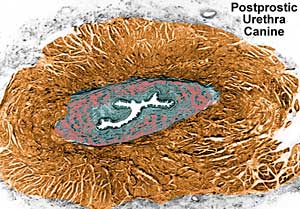 In the prostatic urethra, smooth muscle is structured to contract prostatic lobules, not to serve a urethral sphincter role. The smooth muscle sphincter in male dogs is restricted mainly to the bladder neck.
In the prostatic urethra, smooth muscle is structured to contract prostatic lobules, not to serve a urethral sphincter role. The smooth muscle sphincter in male dogs is restricted mainly to the bladder neck.
• The canine postprostatic urethra features a thick coat of striated urethralis muscle which overlaps the caudal surface of the prostate gland. There is not significant smooth muscle in the postprostatic urethra. Within the submucosa, islands of disseminate prostate gland are evident and a rich stratum spongiosum surrounds the urethral lumen.
